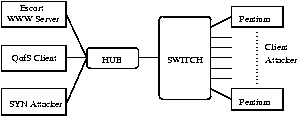
This section reports measurements of Escort designed to demonstrate the costs and benefits of accounting for resource usage across multiple protection domains. The example system we use for all our experiments is the web server introduced in Section 2.
We measured Escort under a variety of configurations and loads, as outlined below.
We tested four configurations of the web server. The first three run on Scout and implement the module graph shown in Figure 1. The fourth configuration runs on Linux. We denote the four configurations as follows:
The experiments place the following kinds of load on the web server:

The full configuration is shown in Figure 7. There are two reasons for this particular hardware configuration. First, it is possible to run a single Client and a single CGI Attacker on each PentiumPro, eliminating the effects of having overly loaded sources. Second, all Client and CGI Attacker traffic share one 100Mbps Ethernet link. This reduces the number of collisions on the hub and gives the QoS traffic enough network capacity to sustain the 1MBps rate.

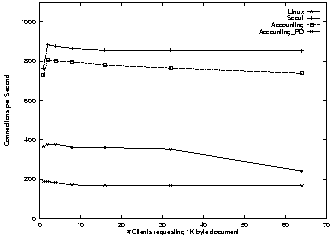
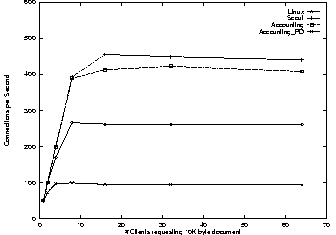
The first set of experiments measure the overhead imposed on the system by Escort's accounting and protection domain mechanisms. Specifically, Figure 8 reports the performance of the web server as it retrieves documents of size 1-byte, 1K-bytes, and 10K-bytes, respectively, from between 1 and 64 parallel clients. All measurements represent the ten-second average measured after the load had been applied for one minute.
The best performance is achieved by the base Scout kernel with Escort's accounting and protection domains disabled; the server is able to handle over two times as many requests as the Apache server running on Linux (800 versus 400 connections per second). This is not surprising considering that Linux is a general-purpose operating system with different design goals. It does, however, demonstrate that we used a competitive web server for our experiments.
Adding fine-grain accounting to the configuration decreases the server's performance by an average of 8%. This decrease in performance can be mostly attributed to keeping track of ownership for memory and CPU cycles.
Adding protection domains decreases the performance by an additional factor of over four. The impact of adding multiple protection domains is rather high, but keep in mind that we configured every module in its own protection domain so as to evaluate the worst-case scenario. In practice, it might be reasonable to combine TCP, IP, and ETH in one protection domain. Each additional domain adds, on average, a 25% performance penalty to the single domain case. We say ``on average'' because the actual cost depends on how much interaction there is between modules separated by a protection boundary.
Another contributing factor is a bug in our OSF1 Alpha PAL code that requires the kernel to invalidate the entire TLB at each protection domain crossing. Other single address space operating systems [14] have shown significant performance improvements by replacing the OSF1 PAL code with their own specialized PAL code. We plan to implement this fix, as well as modify the PAL code in two other ways: (1) to implement some of the system calls directly in PAL code, and (2) to replace the OSF1 page table with a simpler structure of our own. We expect these three optimizations to reduce the per-domain overhead by more than a factor of two.
The difference between 1-byte and 1K-byte documents is less than 3% in most cases, which is not surprising considering that the Ethernet MTU is 1460 bytes and our 100Mbps Ethernet has sufficient capacity. The 10K-byte document connection rate, however, is substantially slowed down by the TCP congestion control mechanisms if less than 16 parallel clients are present. If enough parallel clients are present, the connection rate is between 50-60% of the 1K-byte document case. This seems to be a reasonable slowdown to account for sending multiple TCP segments.
The next set of experiments measure detailed aspects of the architecture.
Table 1 shows the results of a
micro-experiment designed to demonstrate that Escort accounts for all
resources consumed during a single HTTP request; here we focus on CPU
cycles. The first row (Total Measured) reports the measured number of
CPU cycles used during a request for a one-byte document. The
measurement starts when the passive path accepts the SYN
packet---resulting in the creation of an active path that serves the
request---and concludes when the final FIN packet is
acknowledged.
We measured two configurations: the second column (Accounting) gives the results for a configuration that includes accounting but no protection domains, while the last column (Accounting_PD) includes both accounting and protection domains.
| Owner | Accounting | Acounting_PD | |
| Total Measured | 402033 | 1123195 | |
| Idle | 201493(50%) | 9825(1%) | |
| Passive SYN Path | 11223(3%) | 78882(7%) | |
| Main Active Path | 188685(47%) | 1033772(92%) | |
| TCP Master Event | 38(0%) | 514(0%) | |
| Softclock | 92 (0%) | 200 (0%) | |
| Total Accounted | 402031(100%) | 1123193(100%) | |
There are two things to observe about this data. First, Escort accounts for virtually every cycle used, both with and without protection domains. Second, in both the Accounting and Accounting_PD cases, more then 92% of the non-idle cycles are charged to the active path serving the request. Most of the remaining cycles are accounted to the passive path that receives the SYN request and creates the active path. The number of cycles spent in this passive path is constant for each connection, and therefore its share of the overall time will decrease as the active path does more work.
All other cycles are charged to the TCP master event and the softclock. The TCP master event is responsible for scheduling timeouts of individual TCP connections. The softclock increments the system timer every millisecond and schedules the events. The time spent incrementing the timer and scheduling the softclock is charged to the kernel (it is constant per clock interrupt); the TCP master event is charged to the protection domain that contains TCP; and the cycles spent actually processing each TCP timeout is charged to the path that represents the connection.
A second micro-experiment measures the time needed to remove all resources associated with a non-cooperating path. In the experiment, a client requests a document and the server enters an endless loop after the GET request is received. Escort then times out the thread after 2ms and destroys the owner.
| Accounting | Accounting_PD | Linux | ||
| Cycle | 17951 | 111568 | 11003 | |
Table 2 shows the cycles needed to kill the path from the time the runaway thread is detected until all resources associated with the path in all protection domains are destroyed.
The Linux numbers are measured from the time a parent issues a kill signal until waitpid returns. The Linux number are only reported to give a general idea of the cost of destroying a process and should not be directly compared to the Escort numbers. In Escort, the pathKill operation reclaims all resources, including device buffers and other kernel objects. When protection domains are present, all resources associated with the path in every protection domain---as well as all IPC channels and IOBuffers along the path---are also destroyed. As a point of reference, the 111,568 cycles it takes to reclaim resources in a system with both accounting and protection domains represents approximately 10% of the cycles used to satisfy a single request to retrieve a 1-byte document. These numbers should improve as we optimize the inter-domain calls.
We conclude this section by considering three scenarios in which Escort can be used to enforce some resource usage policy. The examples we use were selected to illustrate the impact of policies Escort is able to support. We make no claims that the example policies are strong enough to protect against arbitrary attacks; they are merely representative of policies a system administrator might want to implement.
The first example is a policy that protects against SYN attacks. We assume that there is a trusted part of the Internet and an untrusted part. The goal is to minimize the impact on HTTP requests from the trusted subnet during a SYN attack from the untrusted subnet. Escort implements this policy by providing different passive paths: one accepts SYN requests for the trusted subnet and the other from the untrusted subnet. Each passive path uses a path attribute to keep track of the number of active paths it has created which are in the SYN_RECVD state. This path attribute is monitored by the resource monitor and demultiplexing to the passive path is suspended as soon as 64 paths are in the SYN_RECVD state. Therefore, additional SYN requests are identified as such as early as possible and dropped instantly.

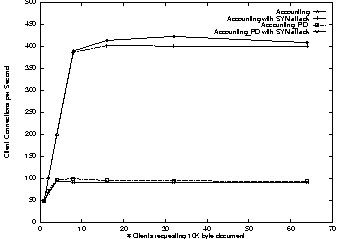
Figure 9 shows the impact on the best effort Client traffic of a SYN attack from the untrusted subnet. The best effort traffic of the Accounting kernel slows down by less than 5% for both document sizes. The Accounting_PD kernel slows down by less than 15%. Both slowdowns are caused by the interrupt handling and demultiplexing time spent on each incoming datagram. The higher slowdown for the Accounting_PD kernel is caused by a higher TLB miss rate during demultiplexing. This is because for each domain-crossing, the TLB is invalidated and, therefore, no mappings for demultiplexing are present.
The performance for the 1K-byte documents are not shown but they are within 3% of the 1-byte document.

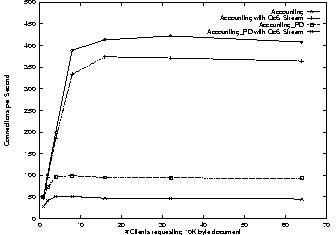
In the next experiment we add one 1MBps TCP stream to the base experiment described in Section 4.2. The point of this experiment is to demonstrate that Escort is able to sustain a particular quality-of-service request in the face of substantial load. Figure 10 shows the impact on the best effort client traffic with and without protection domains. The results for the 1K-byte document are not shown but are again within 3% of the 1-byte document.
Although not shown in the figure, the ten-second average of the QoS stream is always within 1% of the target rate. The Accounting kernel slows down an average of 15%; the Accounting_PD kernel slows down by an average of 50%. This is not a surprising result since Escort with protection domains needs substantially more CPU cycles to sustain a 1MBps data stream.
Note that accounting is required to make QoS guarantees, therefore, we are not able to compare Escort with Linux in this case.
In our final experiment we add 1, 10, or 50 CGI attackers to the previous experiment. As described earlier in this section, each attacker launches one attack per second. Our example policy realizes the attack within 2ms and removes the offending path. As before, we performed this experiment with 1 to 64 clients, document sizes of 1, 1K, and 10K bytes, and a 1MBps guaranteed data stream.


In all cases, the QoS traffic, as measured over ten-second intervals, stays within 1% of the target rate. Since for our example policy we do not distinguish between attackers and clients until the former has used 2ms of CPU time, the system allows connections from attackers with the same probability as from regular clients. This allows the attacker to slow the best effort traffic down substantially since each attacker consumes 2ms worth of CPU cycles before it is detected. This is shown in Figure 11 for the case of 64 concurrent clients. The advantage of Escort in this scenario is that after the attacker path has been detected and killed, all resources owned by the path have been reclaimed.
Note that many alternative policies are possible and easily enforced in Escort. For example, the passive path that fields requests for new TCP connections can be given a limited share of the CPU, meaning that existing active paths are allowed to run in preference to starting new paths (creating new TCP connections). Similarly, clients that have previously violated some resource bound---e.g., the CGI attackers in our example---can be identified and their future connection request packets demultiplexed to a different distinct passive path with a very small resource allocation (or a very low priority). The possibility of IP spoofing, the presence of firewalls, and other aspects may also impact the policy that one chooses to implement. While we believe any such policy can be implemented in Escort, it is not clear that any single policy serves as a silver bullet for all possible denial of service attacks.